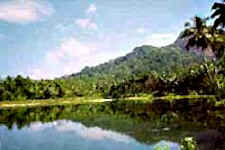Bhothathan Kettu
Home | Bhoothathan Kettu | Periyar Valley Lake | Chelamalai | The Periyar | Thattekad
The river Periyar is the longest river in
Kerala. This is the only perennial river in South India with clean water.
The river occupies an important place in the history of Kerala. In the
Sangam age Tamil epics such as Chilapathikaram, ‘Akananuru’, ‘Purananuru’
etc much has been said about this mighty river, formerly  known as the
‘Choorni nadi’ or ‘Thamraparni Nadi’ (Sukasandesam –stanza 66). A land
route existed in the Sangam age from Mussuris (present-day Kodungalloor)
to Madurai which passed near the banks of the river Periyar. The capital
of the old Chera Empire presumably existed on the banks of the river
Periyar. It is believed that there was a flood in the 4th century AD which
severely damaged the areas along the Periyar and the people living there
had to escape to safer locations, abandoning their homes and livelihoods.
The flood of AD 1341 resulted in the closing of Kodungalloor port and the
opening of a new port at Kochi. The huge landslide that began in the high
ranges as a result of the heavy downpours sent massive flows of mud and
sand which created an Island at the ‘Azhimugham’ of the Periyar which is
now known as the Vyppin Islands.
known as the
‘Choorni nadi’ or ‘Thamraparni Nadi’ (Sukasandesam –stanza 66). A land
route existed in the Sangam age from Mussuris (present-day Kodungalloor)
to Madurai which passed near the banks of the river Periyar. The capital
of the old Chera Empire presumably existed on the banks of the river
Periyar. It is believed that there was a flood in the 4th century AD which
severely damaged the areas along the Periyar and the people living there
had to escape to safer locations, abandoning their homes and livelihoods.
The flood of AD 1341 resulted in the closing of Kodungalloor port and the
opening of a new port at Kochi. The huge landslide that began in the high
ranges as a result of the heavy downpours sent massive flows of mud and
sand which created an Island at the ‘Azhimugham’ of the Periyar which is
now known as the Vyppin Islands.
Several poets of the Sangam age have mentioned the specialty of the water flowing through the Periyar, especially about its medicinal values and curing capacity for several diseases. The Periyar begins in the high ranges in an area where the ‘Neelakoduveli’ – a Mruthasanjeevani (life saving herbal plant) is supposed to grow. It is believed that water flowing in the northern side of the river possesses more medicinal value than that in the south.
The Periyar provides 75% of the electricity consumed by the people of Kerala. Idukki, Pallivasal, Lower Periyar, Mattupetty, Edamalayar and several other hydro electric projects are located on the banks. The biggest irrigation project in Kerala – the Periyar Valley Irrigation Project - which is at present irrigating the entire district of Ernakulam (it is planned to extend its waters to parts of Thrissur district) is at Bhoothathan Kettu. In Bhoothathan Kettu there is a dam just below the sangamam point of the Periyar. Water from the Periyar provides drinking water for the whole city of Cochin, and Alwaye and Perumbavoor towns. There are several heavy industries located on the banks of the Periyar along its reaches below Alwaye. Several pilgrim centers like Malayattoor Church, Alwaye Sivarathri Manalpuram, the birth place of Sri Sankaracharya at Kalady etc. are on the banks of the Periyar.
At present the Periyar is facing several challenges. Unscrupulous sand mining, unrestricted use of pesticides in the paddy fields along the banks of the river and the heavy flow of poisonous waste water from the heavy industries located on its banks are killing the mighty river. Its role as a life saving line, which has been unchanged for centuries, is threatened now.
| Historic Remnants The Sangam age Tamil epics such as Chilappathikaram, Akananooru, Purananuru etc. mention the river Periyar or Choorni Nadi and the rich civilisation that existed on its banks. The remnants of a civilisation comparable to that of Harappa – Mohenjodaro have been found in this area. On the eastern side of Bhoothathankettu, there are eight hills of which the tallest, in the centre, Chelamalai, is believed to be Vanchi, the capital of the early Chera dynasty. The remnants of forts, pathways, wells, bathing ghats, cemeteries etc. located there provide enough proof that this was a very important city once. In the forest on the right bank of the river several Muniaras, |
|
Nannagadies, remnants of old temples, houses, canals etc have been found, which remain in the forest as proof of a rich civilization that existed there in an unclear point of history. The discovery of four gold coins of ‘ Umayya Kalifa’ (AD 661-750) from Kothamangalam (Ernakulam Gazetter p 50), which is very close to Bhoothathan Kettu, proves the rich historic background of this area. Bhoothathan Kettu is the perfect getaway for the history-minded tourist.
